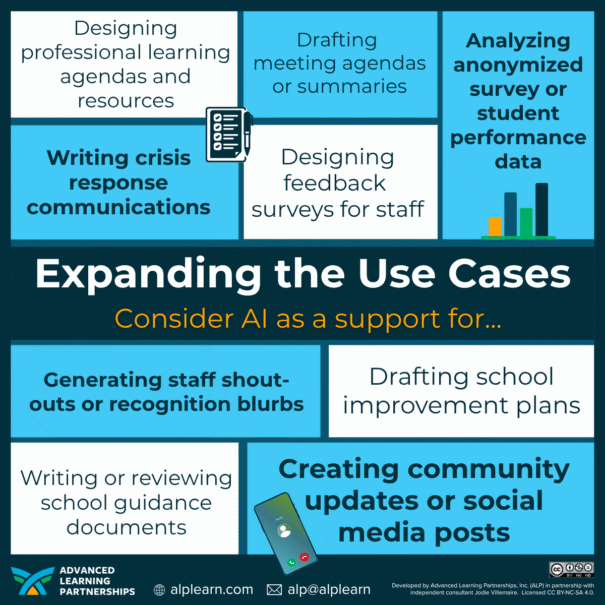School principals constantly manage complexity. From instructional coaching to campus planning, from community outreach to email triage, the days are packed with moment-by-moment decisions. And while efficiency matters, the real power of using AI in school leadership is not simply about saving time. It’s about improving the quality of school leadership and how school leaders communicate their vision, mission, and values with intention, consistency, and clarity.
At ALP, our work with school and district leaders is rooted in principles that keep people at the center and technology as a tool. We believe AI should never replace educators or the leaders who support them. Instead, AI and other technology tools should amplify human connection, increase capacity, and support meaningful, responsible leadership.
Starting with the Why: A Responsible Introduction to AI
When introducing AI tools like ChatGPT, Gemini, or Microsoft Copilot to principals, start with the basics. I always explain what generative AI is, and more importantly, what it is not. It’s not a magic wand. It’s not here to make decisions for you. It’s a tool, one that can partner with you in your leadership work when used with clarity and care.
Before leveraging AI for any task, I lead a conversation about ethics. Principals are responsible for what they share, whether or not it was created with AI. That includes reviewing content for bias, ensuring it aligns with your community values and expertise as an educator. Additionally, confidentiality and professionalism are non-negotiables, so keeping all personally identifiable information out of these tools is essential.
Modeling AI Use and Building Trust
I also encourage school leaders to model transparency in their own use of AI. When principals share openly with their staff about how they’re using tools like ChatGPT to streamline a newsletter or draft a data summary, it opens the door for healthy dialogue and modeling. Teachers become more likely to try these tools themselves, and to do so thoughtfully.
This modeling includes giving credit when AI tools help create something, understanding the boundaries of copyright, and emphasizing that individuals are ultimately responsible for all content and products created with AI. The tool is a tool. Principals are educators, the leaders, and the voice school communities trust.
AI Makes a Difference in Leadership Communication
One of the most powerful applications of AI that I model early in any training with principals, is AI-supported writing, especially powerful when used in time-consuming and high-stakes communication For example, drafting emails to staff or parents about sensitive issues can be tricky. AI can help by offering a first draft that is calm, professional, and clear. Principals still bring their judgment, but AI helps alleviate the pressure of starting from scratch.
AI-support in drafting newsletters is also a powerful application of the tool. I show principals how to upload samples of their past work so that AI can learn their voice. Once trained, the tool can generate a draft in their style, saving them time and ensuring consistency with their tone and values. The goal is not only to communicate more often, but also to communicate better, more clearly, more thoughtfully, and more aligned to your campus culture, goals, and values.
Instructional Leadership Support
AI can also support the instructional side of the principalship. In my sessions, we practice taking observation notes and using AI to connect what we see in classrooms to state teaching standards like T-TESS in Texas or the California Standards for the Teaching Profession. AI can quickly highlight strengths, suggest areas for growth, and propose actionable feedback.
This doesn’t replace the principal’s voice or expertise. In fact, I always remind participants to vet the feedback carefully, edit it for tone, and ensure it reflects what they believe and what they would say directly. Too much feedback can overwhelm a teacher. The principal still decides what matters most and how to communicate it in a constructive way.
Prompts Matter
Every training with principals on using AI includes time on the art of writing effective prompts. A strong prompt tells the AI what role to play, what you want it to do, what tone it should use, and what key details to include. The more specific the prompt, the better the results.
Here’s a simple but powerful example of a prompt used in support of a task aligning teacher feedback to state standards: “You are an experienced instructional coach. Based on these notes, write warm, constructive feedback aligned to Domain 2 of the T-TESS rubric. Keep it under 150 words and include one area of celebration and one suggestion for growth.”
When leaders learn how to prompt well, they get better drafts, faster. They also begin to see AI as a collaborator in their work, not a threat to it.
Expanding the Use Cases
As principals grow more comfortable with early use cases of AI support with communication, I lead them to explore other possibilities where AI can support their complex leadership role. I invite them to consider AI as a support for the following tasks:
- Drafting meeting agendas or summaries
- Designing professional learning agendas and resources
- Writing crisis response communications
- Analyzing anonymized survey or student performance data
- Drafting school improvement plans
- Generating staff shout-outs or recognition blurbs
- Creating community updates or social media posts
- Writing or reviewing school guidance documents
- Designing feedback surveys for staff
Each use of AI supports principals so that they can focus more of their time and attention where it matters most… on people, on learning, and on culture.
Changing Mindsets: A Story from the Field
I had the opportunity to work with a middle school principal in California who, at first, wasn’t sold on the idea of using AI. He was candid about his discomfort. It wasn’t just skepticism, it was a genuine concern about what it would mean to bring artificial intelligence into his leadership practice. He worried it might compromise his personal touch, be perceived as dishonest, or create distance from the thoughtful, values-based leadership he was committed to.
Over time, through ongoing conversations and some personalized coaching, he began to explore how AI tools could actually support the work he was already doing, not replace it. We focused on practical applications that felt aligned with his goals, like using AI to help draft teacher feedback, prepare communications for his campus or community, sketch out personal leadership goals, and build out early drafts of campus improvement plans aligned with student success data.
What made the difference wasn’t just learning what AI could do. It was recognizing that these tools could serve his leadership, not shift it. Today, he’s using them with a clearer sense of purpose, and more confidence in how to integrate them in a way that supports both his values and his vision for his school.
The Human Role Is Central
AI doesn’t lead a school. Principals do. AI won’t walk a hallway, coach a teacher, or build a relationship with a student. What it can do is help principals clear some of the noise so they can focus on human relationships, interactions, and learning conversations with more energy and clarity. AI can help principals communicate more effectively, articulate a vision more clearly, and lead school communities more intentionally.
What made the difference wasn’t just learning what AI could do. It was recognizing that these tools could serve his leadership, not shift it.
The Future of AI and School Leadership
The future of school leadership is not just digital, and it’s not just human. It’s both. At ALP, we support principals in developing a thoughtful, ethical, and empowering relationship with AI, one that keeps people at the center and elevates the work we do for students, staff, and communities.
Wherever you are in your journey with AI, we hope you’ll keep exploring, asking questions, and learning with us. You don’t have to do it alone. To find out more about how ALP supports school leaders, contact us and read these stories of our work supporting school systems in thoughtful adoption of AI:
Teaching the Teachers: Lessons from the Generative AI Literacy Frontlines
Teaching in the Age of AI: What Educators Need to Know and Why It Matters
Professional Learning for AI in K-12: Empowering District Leaders and Transforming Systems
Jodie Villemaire is an ALP consultant with over three decades of experience in public education including administrative leadership roles in Texas public schools. She specializes in executive and leadership coaching, principal mentorship, strategic planning, curriculum development, and organizational change management. Follow Jodie on LinkedIn.
Generative AI was used to organize original thoughts, edit for grammatical errors, and refine ideas for clarity. This content was written through original thinking and revised with a fully human editorial review.


